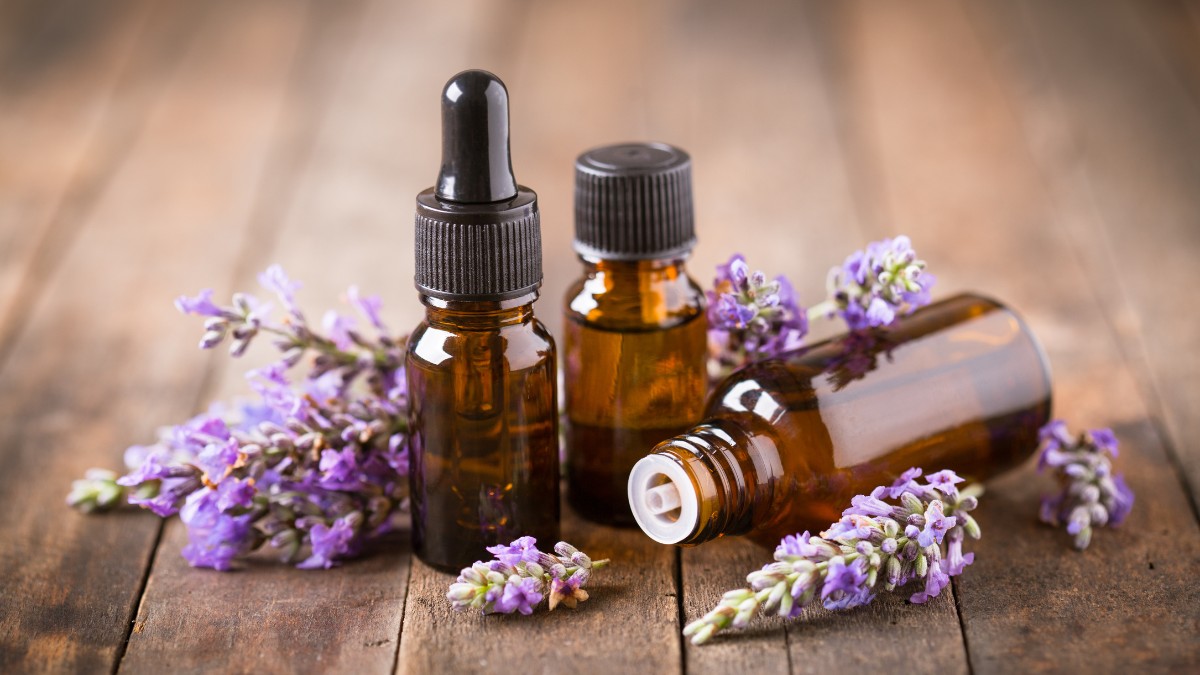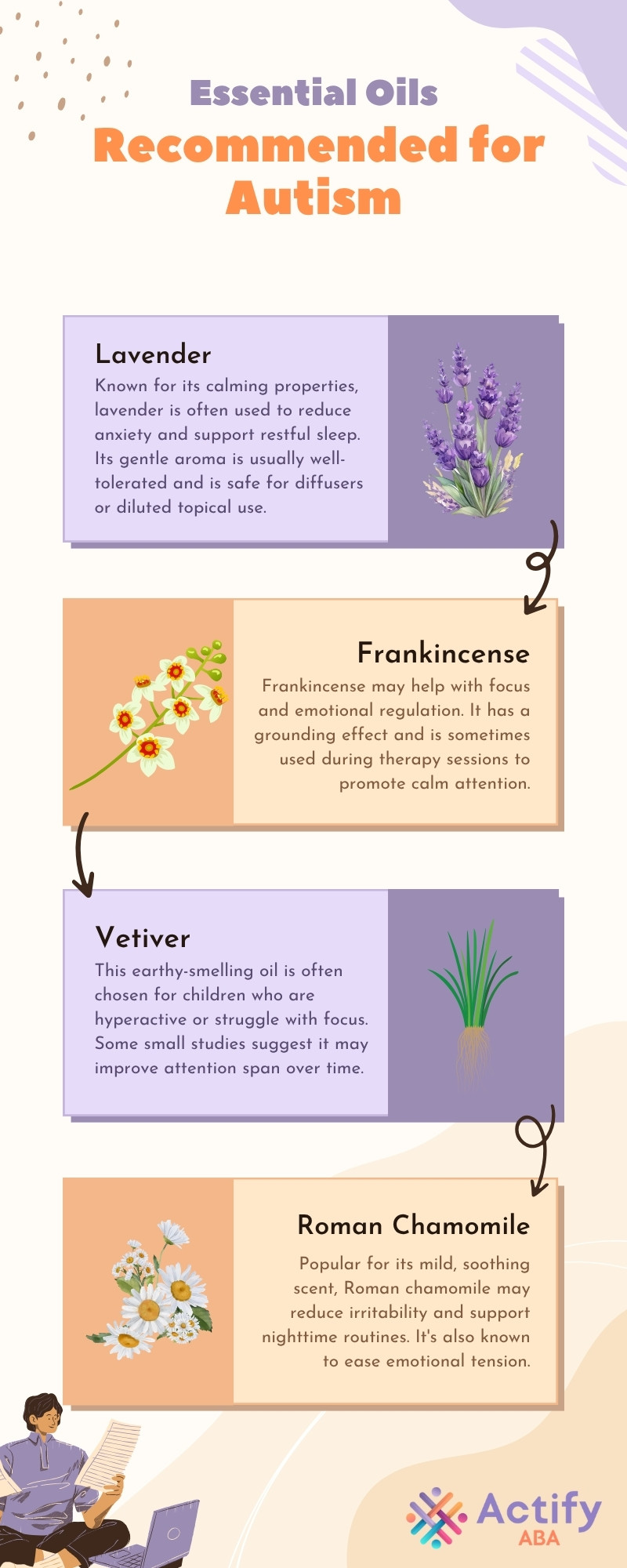
Key Points:
- Aromatherapy for autism may support emotional regulation, sleep quality, and focus when used safely and appropriately.
- Certain essential oils like lavender, frankincense, and vetiver are commonly used for their calming and grounding effects.
- Oils should never replace behavioral therapies, but can be part of a holistic care plan with proper guidance.
For many children with autism, sensory regulation and emotional imbalance are daily challenges. In fact, studies indicate that up to 60% of autistic children experience problems with emotional regulation.
While there’s no cure-all, certain natural strategies—like aromatherapy for autism—are gaining attention from parents looking to ease stress, improve sleep, or enhance focus. In this article, we’ll explore how essential oils, when used carefully, may offer subtle but meaningful support, especially when integrated with other structured interventions like ABA therapy.
What Are the Best Essential Oils for Autism?
There is no one-size-fits-all answer, but lavender, frankincense, vetiver, and Roman chamomile are among the most commonly used essential oils for children with autism, often to support relaxation and focus.
Each essential oil has a unique profile of aromatic compounds that may influence mood, arousal levels, and sensory experience. For children with autism, selecting the right oil depends on their specific needs—whether it’s calming hyperactivity, improving sleep, or reducing sensory overload. It’s important to note that essential oils are not a replacement for evidence-based therapy, but rather a complement that may support self-regulation and well-being.

How Does Aromatherapy for Autism Work?
Aromatherapy works by stimulating the olfactory system—the part of the brain connected to smell—which can influence the limbic system, responsible for emotions and memory. In children with autism, this gentle sensory input can provide either calming or focusing effects depending on the oil used.
Unlike medications, essential oils do not alter brain chemistry, but they may help reduce anxiety or promote relaxation through scent association and sensory integration. Since many autistic children are highly sensitive to smells, introducing oils should be done slowly and with caution.
The possible benefits of aromatherapy for autistic individuals include:
- Calmer transitions between tasks or environments
- Reduced bedtime resistance and better sleep routines
- Improved focus during structured activities
- Fewer meltdowns in overstimulating environments
While scientific evidence is still developing, many families find that the sensory and emotional cues provided by certain oils can play a helpful role in daily routines.
What Are the Most Commonly Recommended Essential Oils for Autism?
Many essential oils are used in aromatherapy plans for autism, but certain oils consistently stand out due to their calming or grounding properties. Below is a list of oils often chosen by families and therapists, along with how each may support sensory or emotional challenges:

Are There Any Possible Side Effects to Using Aromatherapy for Autism?
Yes, while aromatherapy can offer calming benefits for some children with autism, it may also cause side effects, especially in those with heightened sensory sensitivities. Common issues include headaches, nausea, dizziness, skin irritation, or even behavioral agitation if the scent is too strong or unpleasant.
Children on the autism spectrum may process smells differently, so a scent that’s relaxing for one child could overwhelm another. Always use child-safe essential oils, dilute them properly, and introduce new scents slowly. Consulting with a healthcare provider or therapist is recommended before starting aromatherapy to ensure safety and appropriateness for your child’s needs. Just as sensory experiences like scent can vary greatly, other stimuli such as lights may also feel overwhelming for some children. To learn more about how sensory sensitivities affect those with autism, check out our article Why Lights Can Be Overwhelming for Those With Autism.
What are the Safety Considerations for Using Essential Oils with Children?
Essential oils are natural, but that doesn’t mean they’re risk-free, especially for children with autism, who may have heightened sensitivities. Proper use is critical to avoid adverse effects.
Here are essential guidelines for safe use:
Always Start with a Patch Test
Before applying essential oils topically, test a small diluted amount on your child’s skin to check for allergic reactions or irritation. This simple step can prevent discomfort and serious adverse effects, especially in children with sensory sensitivities.
Proper Dilution Is Crucial
Never apply essential oils directly to a child’s skin without diluting them. Use a carrier oil like coconut or jojoba, and follow child-safe ratios—typically 0.5% to 1% dilution for kids under 6. This helps minimize irritation and absorption risks.
Avoid Strong Scents and Direct Inhalation
Children with autism may react strongly to intense smells. Avoid placing oils near their face or nose, and do not use oils that are known to be too strong (like peppermint or eucalyptus) in young children.
Use Diffusers in Short, Controlled Sessions
When using diffusers, ensure the space is well-ventilated and limit diffusion to 15–30 minutes. Overexposure can lead to headaches, nausea, or sensory overload, particularly in children who are scent-sensitive.
Involve your child in scent selection when possible. Giving them a choice between a few options can build tolerance and ensure they’re comfortable with the aroma.
How Can Essential Oils Be Incorporated into Daily Routines?
Consistency and predictability help children with autism thrive. That applies to aromatherapy too. When integrated into existing routines, essential oils can serve as sensory cues that signal comfort, sleep, focus, or transition.
Some ways to use oils include:
1. Bedtime Wind-Down
Diffuse lavender or Roman chamomile for 20 minutes before bed. This helps establish a sensory signal that sleep is coming.
2. Morning Focus Routine
Vetiver or cedarwood can be applied (diluted) to wrists or behind ears before starting a school day or therapy session.
3. Calming Corner or Sensory Breaks
Use a calming blend (lavender, frankincense, bergamot) in a diffuser near a sensory station or quiet space.
4. On-the-Go Regulation
Create a roller bottle with a soothing blend for quick use during transitions, car rides, or outings.
5. Therapy or Homework Sessions
Diffuse oils that support attention (like vetiver or frankincense) to help set the tone for focus.
Pairing aromas with specific tasks helps the child form positive associations and strengthens self-regulation strategies.
What Should Parents Know Before Starting Aromatherapy?
Before starting aromatherapy, parents should understand that while essential oils can support emotional wellness, they are not a treatment or therapy on their own. Their best use comes as a supplemental tool that complements structured supports like ABA, speech, or occupational therapy.
Here are some helpful starting tips:
- Start small with one oil at a time to monitor your child’s reaction.
- Choose high-quality, therapeutic-grade oils free of synthetic additives.
- Keep oils out of reach to ensure safety and prevent accidental ingestion.
- Consult with your child’s therapy team before adding aromatherapy to the care plan.
- Observe behavior before and after introducing oils to determine effectiveness.
Remember, what works for one child may not work for another. Sensory preferences are highly individual in autism, and that includes smell. The goal is to find what supports your child’s well-being, not to follow a one-size-fits-all approach. To explore more about how different sensory tools can help, check out our article Do Fidget Toys for Autism Really Work? Find Out Here.
Is Aromatherapy a Substitute for Behavioral Therapy?
No, aromatherapy is not a replacement for behavioral therapies like ABA. While essential oils may provide sensory support and emotional relief, they do not teach communication, social, or adaptive skills. Aromatherapy lacks the structured teaching and data-driven decision-making of behavioral science.
However, when used responsibly, aromatherapy can enhance the environment where learning happens. A calm, regulated child is more likely to engage in therapy, follow routines, and communicate needs. When combined with effective interventions, essential oils can be one more helpful tool in the toolbox.
Nurture Your Child’s Progress with ABA Therapy
While aromatherapy may support regulation and relaxation, behavior change happens through structured, evidence-based approaches. At Actify, we offer ABA therapy in Maryland, helping children with autism build the skills they need to thrive emotionally, socially, and academically.
Our therapists focus on individualized plans that include support for sensory sensitivities, emotional regulation, and communication development. We work with parents to understand the full context of your child’s needs, including sensory triggers, and integrate behavior strategies that lead to lasting progress.
If you’re exploring ABA therapy in Maryland, reach out to us today. Together, we can support your child’s growth in a calm, structured, and nurturing environment.
